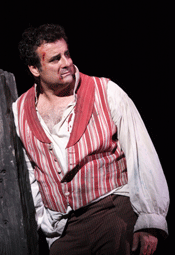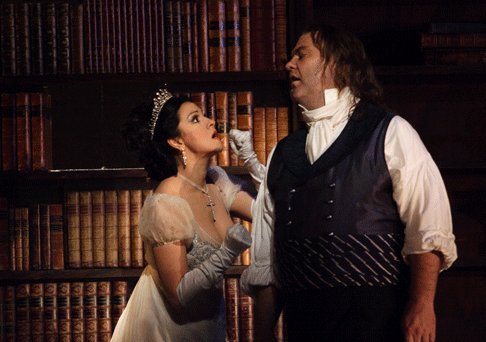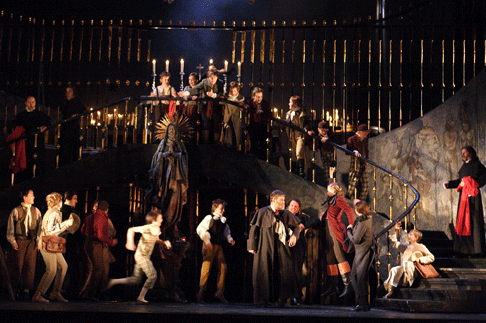12 Jul 2009
Tosca at Royal Opera House
This revival of Jonathan Kent’s 2006 production of Tosca brings to an end the ROH’s ‘Italian Season’ in fine style.

This revival of Jonathan Kent’s 2006 production of Tosca brings to an end the ROH’s ‘Italian Season’ in fine style.
The season has hardly had a dud moment, the highlight perhaps being the momentous Barbiere but this Tosca has to run that a close second, with its central trio of singers as well balanced as anyone could possibly desire, excellent orchestral sound under Jacques Lacombe and a staging which respects the opera’s traditions yet does not become mired in them.
 Marcello Giordani as Cavaradossi
Marcello Giordani as Cavaradossi
I have not previously warmed to Angela Gheorghiu’s singing, but this is a part which she seems to have been born to play — she’s a diva, after all, and the pseudo-coquettish shenanigans in Act I were bearable in her hands and voice where they grate from others, and the histrionics of later on were convincingly done — on this showing if poor Cavaradossi had lived, he would probably not have survived ‘il Bacio di Tosca’ for very long. She sang ‘Vissi d’arte’ with limpid tone and a kind of heartfelt beseeching of which I had not thought her capable, and her scenes with Cavaradossi, especially those describing their idyllic future, were very moving.
Marcello Giordani, a sadly infrequent guest here in London, is the Met’s tenor of choice, and it’s easy to hear why — this is a powerful, juicy, ringing voice but it is much more bel canto in style than the usual bulldog can belto in this role, and for once you could actually imagine this aristo turned Voltairean as a painter. He and Gheorgiou seemed to have a natural chemistry, the often stagy love scenes actually convincing, and he passed what to my mind is the true test of a great Cavaradossi, with a tender, finely phrased account of ‘O dolci mani.’
Bryn Terfel seems to have taken to heart the libretto’s instruction in Act III, that he should sing ‘insinuante e con intenzione’ — this was a creepy, malevolent Scarpia, one before it was easy to imagine that all Rome had trembled. I was less convinced by his desire for Tosca — the cries of ‘Ah! Tosca’ and ‘finalmente mia!’ sounding more complacent than impassioned — but his wrath was horrible to contemplate, made even more so by the characteristic retention of a beautiful, smooth legato line.
 Angela Gheorghiu as Tosca and Bryn Terfel as Scarpia
Angela Gheorghiu as Tosca and Bryn Terfel as Scarpia
The smaller parts were admirably taken, Martyn Hill a finely oily Spoletta, Kostas Smoriginas a sympathetic Angelotti, and Jeremy White an avuncular, expressive Sacristan. Orchestrally we were in surprisingly commanding hands, given that the conductor was making his house debut conducting opera (he has been a stalwart of the Ballet for some time) — the lower strings especially had been coaxed into chamber music-like intimacy and the brass sparkled rather than blared.
The production is traditional in the best sense, in that Paul Brown’s designs present mostly realistic depictions of Sant’ Andrea and the Castel Sant’Angelo, the latter set against a deep blue, starry sky emblazoned with a central angel’s wing, finely suggesting both Bernini’s Angel on the bridge by the castle, and the ‘Avenging Angel’ which stands atop the building. The central influence in Scarpia’s study seems to be Cellini, the massive quality of his bronzes suiting the man’s power and ego. Mark Henderson’s lighting evocatively suggests both claustrophobic interiors and encroaching night, and Stephen Barlow’s direction of the principals follows Jonathan Kent’s naturalistic, unforced approach.
 A scene from Tosca
A scene from Tosca
Like the previous Visconti staging, this Tosca will be with us for many years, but it is hard to imagine it being graced with such strong principal singers as this time around. Just four more performances, on July 11th, 14th, 16th and 18th.
Melanie Eskenazi